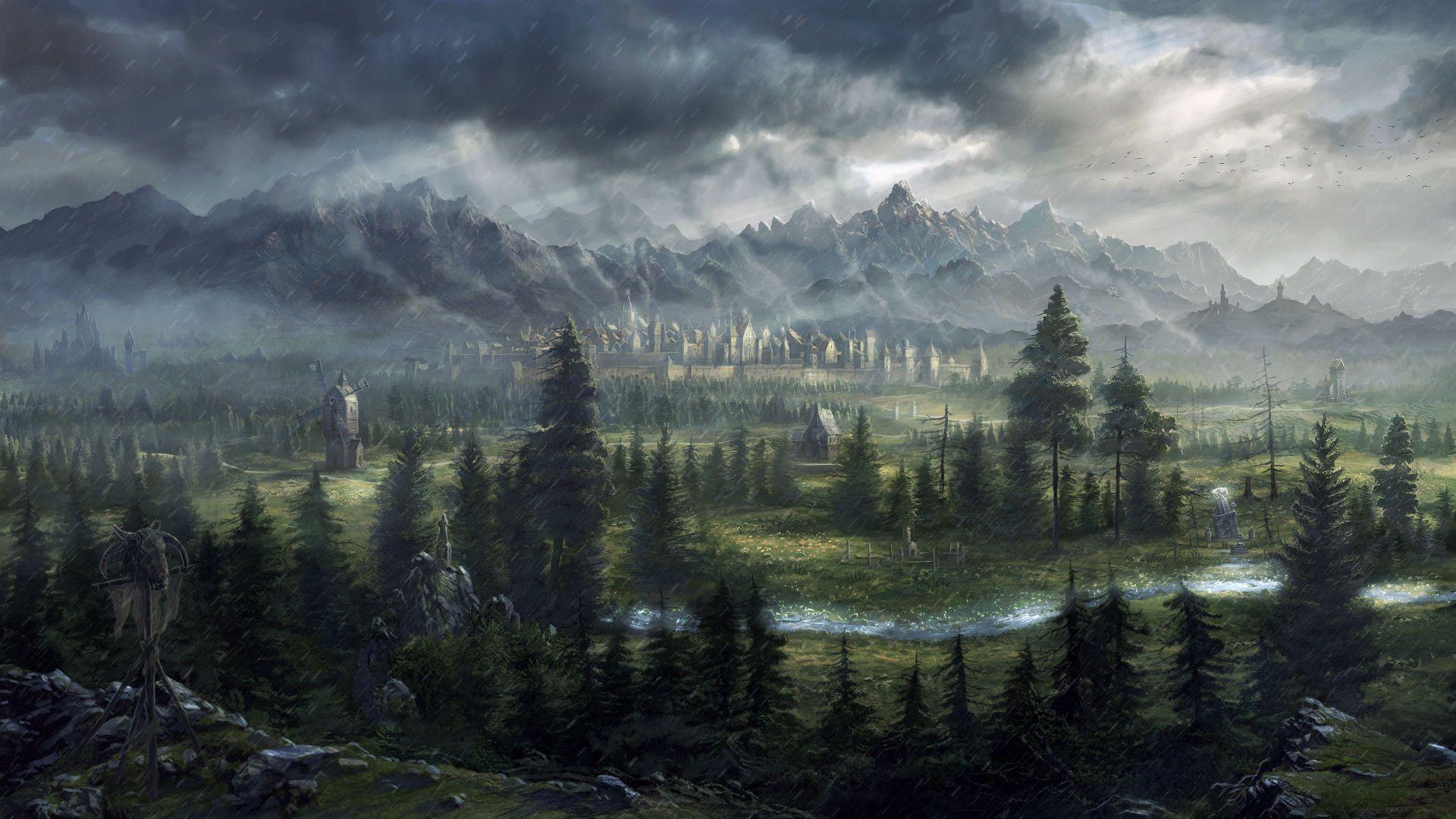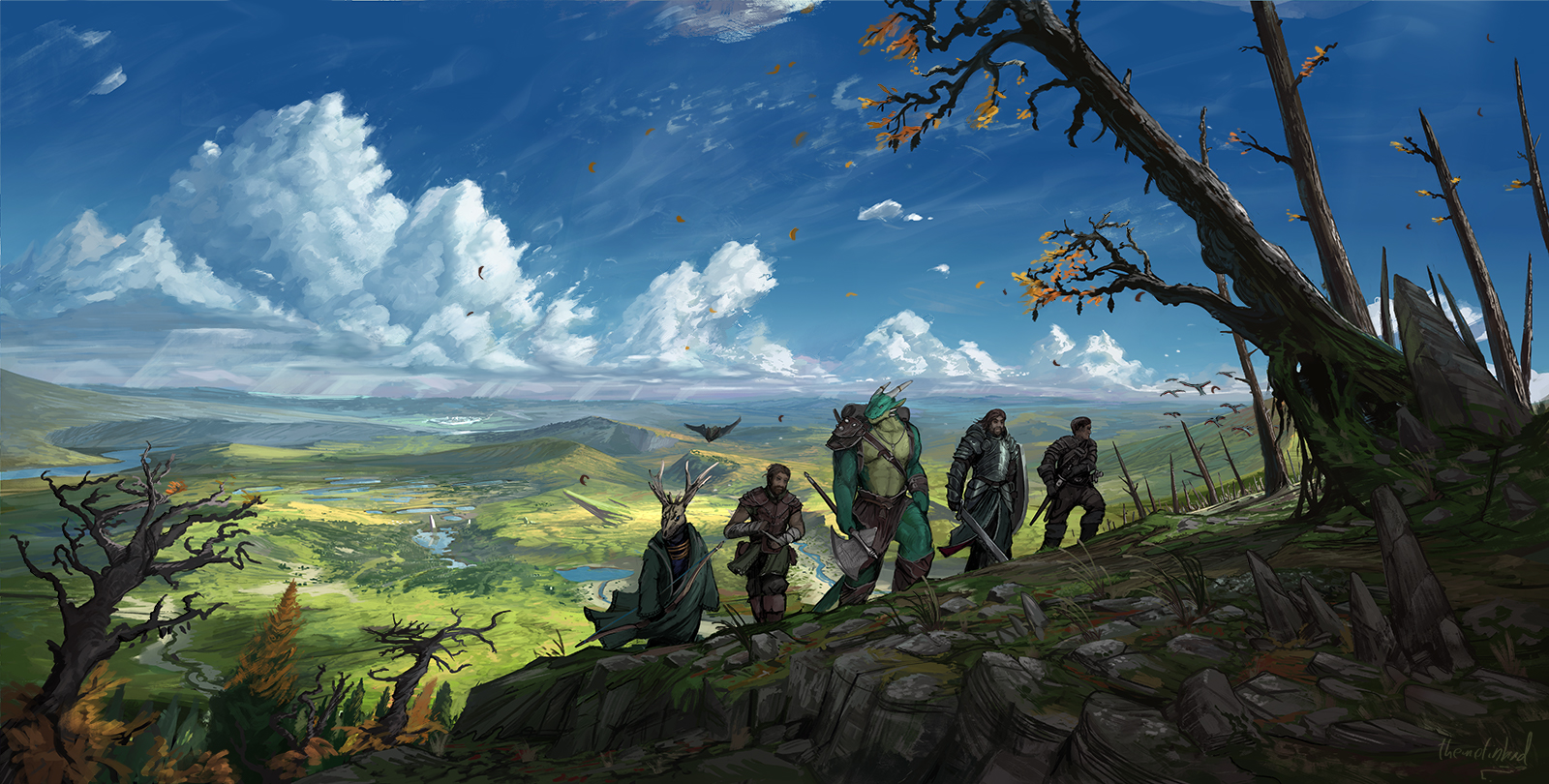Another DM Guide
For One Shots and other short campaigns

“You don’t want them to die,
But you want them to
think they are going to die”
Homebrewed by Logan Mulderrig
One-Shot Adventure Breakdown for New DMs
A successful one-shot adventure should include a balanced mix of roleplaying, combat, and problem-solving while keeping the story concise and engaging.
In this breakdown, we’ll guide you through the essential elements of a one-shot, providing detailed examples of each component.
1. Setting and Plot Hook Start by introducing the ground and a compelling plot hook to motivate the characters.
The characters arrive at the small coastal town of Windhaven, known for its mysterious lighthouse. They learn that the lighthouse’s keeper has gone missing, and the city is in danger of being attacked by sea monsters attracted to the unlit beacon.
2. Roleplaying Encounter (NPC) Create at least one memorable NPC to provide information, assistance, or conflict.
The characters meet Captain Elara, a concerned town guard. She explains the situation and pleads for the characters’ help finding the lighthouse keeper and relighting the beacon. Captain Elara rewards the characters for their assistance and provides them with valuable information about the lighthouse’s layout.
3. Puzzle or Challenge Include a puzzle or non-combat challenge that encourages creative problem-solving.
The characters discover that the lighthouse door is magically sealed with a riddle. They must solve the puzzle to gain entry: “I have cities but no houses, forests but no trees, and rivers but no water. What am I?” (Answer: A map)

4. Combat Encounter (Fight) Design a balanced combat encounter with engaging enemies that challenge the characters.
Upon entering the lighthouse, the characters face a group of sahuagin who have captured the lighthouse keeper. The sahuagin are responsible for extinguishing the beacon and are using the keeper as bait for the sea monsters. The characters must defeat the sahuagin to rescue the keeper.
5. Treasure and Rewards Reward the characters with loot, gold, or other valuables for their efforts.
After defeating the sahuagin and rescuing the lighthouse keeper, the characters find a hidden compartment containing a magical trident, 200 gold pieces, and a map to a nearby sunken ship filled with treasure. Additionally, Captain Elara rewards them with the gratitude of the townsfolk and a discount on goods and services in Windhaven.
6. Conclusion and Adventure Ties Wrap up the adventure by resolving the main story and potentially connecting it to other one-shots or future experiences.
The characters relight the beacon, driving away the sea monsters and saving Windhaven. As a result, the townsfolk celebrate their heroes, and rumors spread of their bravery. The characters can explore the sunken ship on their next adventure or use their newfound reputation to find new quests in nearby towns.
Incorporating these elements into your one-shot will create a well-rounded and engaging experience for your players.
Remember to adapt and improvise to accommodate your players’ choices and preferences.
Chapter 1 | One-Shot Adventure Breakdown for New DMs
Becoming a Dungeon Master: A Guide to DMing One-Shots in DnD 5e
Introduction
Welcome, you are aspiring Dungeon Masters! This guide will help you learn the essentials of being a successful Dungeon Master (DM) in Dungeons & Dragons 5th Edition (DnD 5e), focusing on one-shot adventures. As the master storyteller and referee, you guide players through exciting, engaging, stand-alone experiences. This document will provide you with the knowledge and tools needed to make your game sessions memorable and enjoyable for everyone involved.
- The Role of the Dungeon Master
- Preparing for Your First One-Shot
- Building One-Shot Adventures
- Creating Encounters and Challenges
- Running Combat and Managing Rules
- Roleplaying NPCs and Encouraging Player Interaction
- Handling Player Conflict and Problem-Solving
- Improvisation and Adaptability
- Tips and Tricks for Successful DMing in One-Shots
- Resources and Further Reading
The Role of the Dungeon Master
As a DM, your responsibilities include the following:
- Crafting a story and setting for your players to explore
- Creating and roleplaying non-player characters (NPCs)
- Designing encounters, puzzles, and challenges
- Managing game rules and mechanics
- Facilitating player decisions and actions
- Encouraging collaboration and teamwork among players
Remember that your primary goal is to ensure everyone at the table has fun and feels included.
As the DM, you describe how the adventurers enter the small village of Rivershore, surrounded by a thick forest. You introduce a nervous farmer who approaches the party, pleading for help to save his daughter from a band of goblins that kidnapped her. You facilitate the players’ decisions and describe the outcome of their actions, ensuring an engaging and immersive experience.
Preparing for Your First One-Shot
Before starting your first one-shot, you’ll want to:
- Familiarize yourself with the DnD 5e rulebooks, particularly the Player’s Handbook, Dungeon Master’s Guide, and Monster Manual
- Choose or create a one-shot adventure suitable for your players’ levels and interests
- Gather necessary materials (dice, character sheets, maps, etc.)
- Invite players and help them create or select pre-generated characters
- Provide a brief introduction to the adventure’s setting and objectives
You run “The Mad Manor of Astabar,” a one-shot adventure for level 3 characters. You gather your materials, invite four friends to play, and provide them with pre-generated characters. You briefly describe the haunted manor’s history and rumors of a hidden treasure.

Chapter 2 | Becoming a Dungeon Master: A Guide to DMing One-Shots in DnD 5e
Building One-Shot Adventures
When designing a one-shot, consider the following elements:
- A clear and concise plot that can be completed in one session
- A balance of combat, exploration, and roleplaying opportunities
- Exciting and varied NPCs to interact with
- A self-contained setting that can be connected to other one-shots if desired
- Scalable challenges to accommodate varying player levels and party sizes
You design a one-shot where the players must infiltrate a castle and retrieve a stolen artifact. The adventure includes a stealthy approach through secret tunnels, negotiations with a disgruntled guard, and a climactic battle against the artifact’s thief, all set within a richly detailed and atmospheric castle.
Creating Encounters and Challenges
Design engaging encounters by:
- Tailoring meetings to suit the characters’ abilities and backgrounds
- Using diverse enemies and environments
- Providing multiple solutions to puzzles and challenges
- Incorporating a mix of combat, skill checks, and social interactions
In your one-shot, the players must cross a chasm guarded by a hungry wyvern. They can attempt to fight it, negotiate with it by offering food, or find an alternative route by scaling the chasm’s walls. The encounter combines combat, roleplaying, and skill checks, catering to different player preferences.

Homebrew Mug
Running Combat and Managing Rules
As a DM, it’s essential to:
- Know the basic combat rules and be ready to look up specifics when needed Maintain a fair and consistent approach to rule interpretation Encourage strategic and creative thinking from players during combat
During a combat encounter, a player’s character casts a spell you’re unfamiliar with. You quickly reference the spell’s description in the Player’s Handbook to understand its effects, then adjudicate the outcome fairly and consistently with the rules.
Roleplaying NPCs and Encouraging Player Interaction
Create memorable NPCs by: Giving each NPC distinct personality traits, goals, and motivations Using varied voices, accents, and mannerisms to bring NPCs to life Encouraging players to interact with NPCs and the environment through engaging descriptions and roleplay opportunities
You introduce a sly merchant NPC who tries to swindle the party into buying a fake magical item. You roleplay the merchant with a distinct voice and mannerisms, engaging the players in conversation and encouraging them to use their skills to determine the item’s true nature.

Chapter 2 | Becoming a Dungeon Master: A Guide to DMing One-Shots in DnD 5e
Handling Player Conflict and Problem-Solving
To manage player conflict effectively, you should: Encourage open communication and understanding between players Be prepared to mediate disputes and help find a compromise Foster a collaborative and inclusive atmosphere at the table
Two players argue over whether to help a group of villagers or pursue a personal vendetta. As the DM, you facilitate a discussion, encouraging the players to consider each other’s perspectives and find a solution that satisfies their characters’ motivations.
Improvisation and Adaptability
To be an adaptable and improvisational DM, you should: Be prepared for unexpected player choices and actions Be willing to adjust your plans to accommodate player decisions Think on your feet and use improvisation to maintain an engaging story
Your players decide to explore an area you must prepare. Instead of railroading them back to the planned content, you quickly improvise a side encounter that ties into the main story, maintaining the players’ sense of agency and immersion.
Tips and Tricks for Successful DMing in One-Shots
To optimize your DMing skills for one-shots, consider the following tips:
- Keep the story focused and concise to fit within the allotted time
- Use pre-generated characters or simplified character creation to save time
- Encourage players to make decisions promptly without rushing them
- Be prepared to adjust encounters and challenges based on player feedback
To keep the one-shot on track and within the allotted time, you set a real-world timer for encounters, subtly nudging players to make decisions and maintain a brisk pace without rushing them.
Resources and Further Reading
Expand your knowledge and improve your DMing skills by utilizing the following:
- Official DnD 5e rulebooks and supplements
- Online resources, such as forums, blogs, and podcasts
- Pre-written one-shot adventures for inspiration and guidance
- Feedback from players and fellow DMs to learn and grow
To find inspiration and guidance for designing one-shots, you explore resources like the DM’s Guild, which offers a variety of community-created adventures, or you listen to podcasts like “The Adventure Zone” and “Critical Role” to learn from experienced DMs.

Chapter 2 | Becoming a Dungeon Master: A Guide to DMing One-Shots in DnD 5e
A “Short” List of Tips and Tricks
Here’s a collection of tips and tricks for playing and running DnD, compiled from various online sources and experienced players:
- Session Zero: Have a session zero where players create their characters together and discuss their backstories, relationships, and the campaign’s setting and tone. This helps build group cohesion and sets expectations for everyone involved.
- Use Props: Enhance immersion and atmosphere by using physical props like maps, letters, or costumes. These tangible items can make your game world feel more genuine and engaging.
- Encourage Note-Taking: Encourage players to take notes during sessions, as this helps them remember essential NPCs, locations, and plot points, making the world feel more alive and connected.
- “Yes, and…”: Embrace the improv concept of “yes, and…” when responding to player actions. This means going along with their ideas and adding to them rather than shutting them down.
- Use a DM Screen: A DM screen can help keep your notes, maps, and rolls hidden from players, adding an element of mystery and surprise to the game.
- Pre-Roll Initiative: To save time during combat, consider the pre-rolling initiative for NPCs and monsters before the session begins.
- Keep Combat Engaging: Describe combat vividly and dynamically, and encourage players to do the same. This helps make combat feel more cinematic and engaging.
- Offer Choices: Present players with multiple options and paths to choose from so they feel like their decisions matter and have consequences.
- Be Flexible: Be prepared to adapt your plans and story based on player actions and decisions. This demonstrates that their choices have an impact on the world.
- Use the Rule of Three: When presenting clues or plot hooks, provide at least three ways for players to discover them. This increases the chances that players will find the information they need.
- Establish House Rules: If you have specific expectations or rules for your table, communicate them clearly before starting the campaign.
- Learn from Others: Watch or listen to actual play podcasts and live streams, such as “Critical Role” or “The Adventure Zone,” to learn tips and tricks from experienced DMs and players.
- Reward Creativity: Encourage and reward creative solutions and roleplaying by offering inspiration points or other in-game bonuses.
- Take Breaks: Schedule breaks during sessions to allow players to relax, chat, and recharge.
- Seek Feedback: After each session, ask players for feedback on what they enjoyed and what could be improved. Use this feedback to grow and adapt your DMing style.
- Remember the Fun: DnD is a game; the ultimate goal is for everyone to have fun. Keep this in mind and prioritize the enjoyment of the players and yourself.
- Please keep Track of Time: Use the in-game time to help players manage their resources, such as spells and hit points, and to create a sense of urgency when necessary.


Chapter 3 |A “Short” List of Tips and Tricks
- Utilize “Theater of the Mind”: Not every combat or encounter needs a detailed map and miniatures. Sometimes, simply describing the scene and allowing players to use their imagination can be as effective and engaging.
- Share the Spotlight: Ensure that each player has a chance to shine and contribute to the game. Encourage quieter players to participate and avoid letting more outspoken players dominate the session.
- Create Interesting NPCs: Make your NPCs memorable by giving them unique traits, quirks, and voices. This helps bring the world to life and encourages player interaction.
- Start Sessions with a Recap: Begin each session with a recap of the previous session’s events to remind players where they are and what they’ve accomplished.
- Use Music and Sound Effects: Incorporate background music and sound effects to create an atmosphere and enhance the gaming experience.
- Offer Customized Magic Items: Reward players with unique, personalized magic items that cater to their character’s abilities, backstory, or goals.
- Encourage Backstory Development: Encourage players to develop their characters’ backstories and motivations and then weave those elements into the campaign narrative.
- Provide Non-Combat Encounters: Not all encounters need to be combat-focused. Include social, exploration, and problem-solving encounters to offer variety and cater to different player preferences.
- Utilize a Session Checklist: Before each session, create a checklist of essential NPCs, plot points, and encounters to ensure you’re prepared and organized.
- Incorporate Player Feedback: Use player feedback to help shape the campaign and address any issues.
- Use Random Encounter Tables: Create random encounter tables to add an element of unpredictability and spontaneity to your game.
- Establish Clear Consequences: Make sure players understand the potential consequences of their actions, both positive and negative, to create a sense of realism and accountability.
- Don’t Be Afraid to End a Campaign: If a campaign has reached its natural conclusion or isn’t enjoyable for the group, feel free to end it and start a new adventure.
- Use Milestone Leveling: Instead of tracking experience points, consider using milestone leveling, where players level up after achieving significant story goals or completing challenging encounters. This can help maintain a narrative focus and reduce bookkeeping.
- Create a Living World: Make your game world feel alive by having events occur independently of the player’s actions, such as political changes, natural disasters, or festivals.
- Use Visual Aids: Provide visual aids like maps, pictures, or handouts to help players better understand and visualize the world and its inhabitants.


Chapter 3 |A “Short” List of Tips and Tricks
- Allow for Downtime: Give players opportunities for downtime activities, such as crafting items, researching lore, or establishing connections with NPCs. This can help players feel more connected to the game world and their characters.
- Introduce Plot Twists: Surprise your players with unexpected plot twists or reveals to keep the story exciting and unpredictable.
- Use a Variety of Encounter Types: Mix up your encounters by including different types of enemies, environments, and objectives to keep combat fresh and engaging.
- Encourage Teamwork: Design encounters and challenges that encourage players to work together and utilize their unique skills and abilities.
- Foster Player Agency: Allow players to make meaningful choices that impact the story and respect their decisions, even if they lead to unexpected outcomes.
- Emphasize Exploration: Encourage players to explore the world by providing exciting locations, hidden secrets, and intriguing mysteries.
- Incorporate Player Goals: Learn about your players’ character goals and try incorporating them into the campaign narrative.
- Stay calm: If you have new players at the table, take the time to explain the game mechanics and help them feel comfortable and engaged.
- Manage Table Talk: Encourage in-character conversation, but be mindful of excessive out-of-character table talk that can detract from the game.
- Prepare NPC Names: Create a list of random NPC names to have on hand for when players inevitably ask for the name of an unplanned character.
- Create Interesting Locations: Design unique and memorable locations for your players to explore, with distinct features and challenges.
- Take Inspiration from Other Media: Draw inspiration from books, movies, TV shows, and video games to create engaging stories, characters, and encounters.
- Use Flashbacks: Employ flashbacks to reveal character backstories, provide context for current events, or foreshadow future plot points.
- Keep a DM Journal: Keep a journal of your campaign’s events, NPCs, and locations to help you stay organized and maintain continuity.
- Embrace Failure: Allow players to fail and face the consequences, but try to turn failures into opportunities for new adventures and character growth.
- Maintain a Sense of Humor: Keep a light-hearted atmosphere at the table, and don’t be afraid to incorporate humor into your campaign.
- Remember Self-Care: As the DM, remember to take care of yourself, manage your time effectively, and communicate your needs to the group.



Chapter 3 |A “Short” List of Tips and Tricks